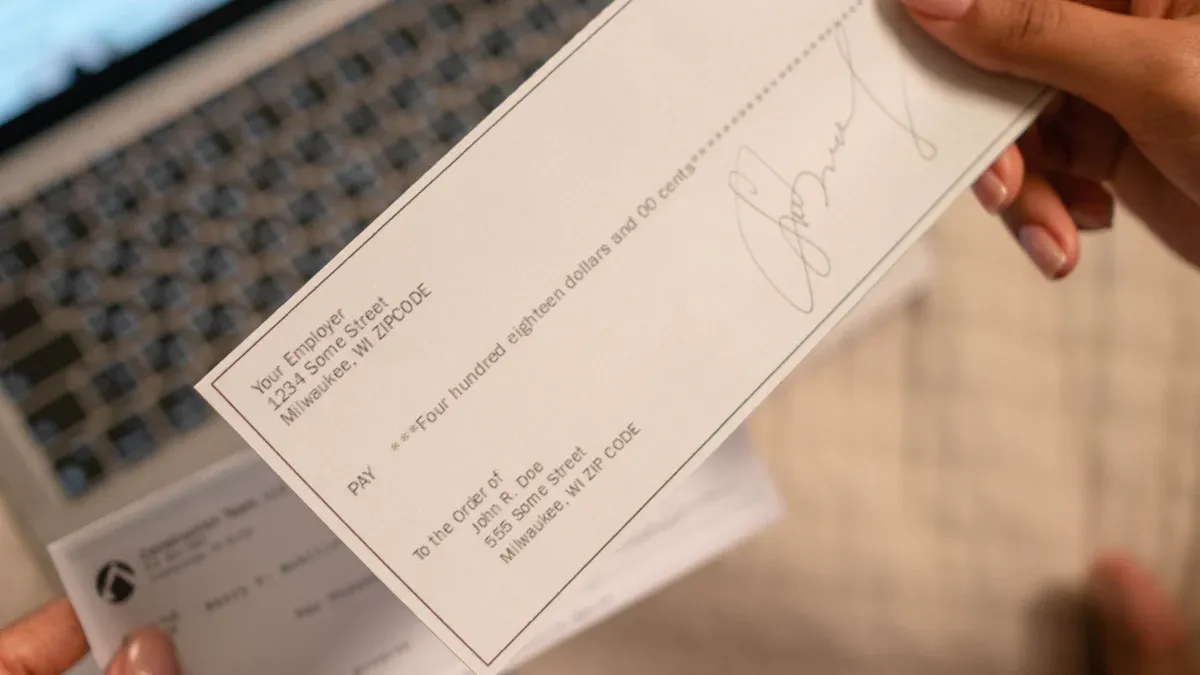- EasyCard
- Trade
- Help
- Announcement
- Academy
- SWIFT Code
- Iban Number
- Referral
- Customer Service
- Blog
- Creator
How Much Transfer in the US Will Be Investigated? Key Issues You Must Know Before Remitting Money

Image Source: pexels
Many people are concerned about US transfer regulations. A key figure is $10,000. For any single or cumulative cash transaction exceeding this amount within 24 hours, banks must report to the government.
You do not need to worry excessively; this is just the bank’s routine compliance operation. In fact, US financial institutions submitted over 16 million such reports in 2022. This does not mean your funds are problematic or that you need to pay taxes immediately. Understanding these rules can help you handle funds legally and compliantly.
Key Takeaways
- In the US, banks report single or cumulative cash transactions over $10,000 within 24 hours to the government; this is just a routine procedure.
- Deliberately splitting large transactions into smaller ones to avoid reporting is illegal, known as “structuring,” which can lead to severe fines or imprisonment.
- Money received as gifts from family or friends usually does not require taxes, but if the amount is large, the giver may need to report it, and the recipient may also need to report large overseas gifts.
- When receiving business payments via platforms like PayPal, if the amount reaches a certain threshold, the platform will report to you and the IRS, but Zelle will not.
- For large transfers, choosing bank wire transfers or online remittance companies has its pros and cons; understanding their limits and fees can help you make the best choice.
Core Reporting Rules: $10,000 Threshold

Image Source: pexels
The $10,000 figure is a key “red line” in the US financial regulatory system. Once your transaction touches this threshold, it triggers reporting procedures. But this set of rules is not only for banks; individuals and businesses also have reporting responsibilities in certain situations. Understanding these responsibilities is the first step to legally conducting large US transfers.
Banks and Individuals’ Reporting Responsibilities
Reporting responsibilities are mainly divided between two parties: the financial institutions you work with and, in some cases, yourself.
- Banks’ Responsibility: Submit Currency Transaction Report (CTR) Under the US Bank Secrecy Act (BSA), all financial institutions, including banks and credit unions, must assist the government in preventing financial crimes. When you conduct a single or cumulative cash transaction (such as deposits, withdrawals, or exchanges) exceeding $10,000 within 24 hours, the bank must complete and submit a Currency Transaction Report (CTR) to the Financial Crimes Enforcement Network (FinCEN).
- Individuals’ Responsibility: SubmitForm 8300 As the recipient, you may also need to report. The IRS stipulates that if you receive more than $10,000 in cash from a single or related transaction in business or trade activities, you must submit Form 8300 to the IRS within 15 days of receiving the payment.
What is the key information for Form 8300 reporting? When filling out this form, you need to provide detailed information, including:
- Payer Information: Name, address, Social Security Number (SSN) or Taxpayer Identification Number (TIN).
- Transaction Information: Total transaction amount, cash payment amount, transaction date, and type.
- Recipient Information: Your business name, address, and Employer Identification Number (EIN).
At the same time, you are obligated to notify the payer in writing by January 31 of the following year that you have reported this receipt to the IRS.
The True Meaning of Reporting
Many people get nervous upon hearing “reporting,” fearing they are targeted by the IRS. You need to understand that reporting does not equal taxation, nor does it mean your funds are problematic.
The main purpose of reporting is to enhance financial transparency. According to FinCEN and IRS explanations, the primary roles of these reports are:
- To provide investigative leads for law enforcement to combat money laundering, terrorist financing, and other illegal activities.
- To establish a clear “audit trail” in tax audits and criminal investigations.
For the vast majority of individuals and businesses with legitimate fund sources, the submission of CTR or Form 8300 is just a routine compliance record. As long as your fund sources and uses are legal, there is no need for excessive concern.
Risks of Structuring
Since transactions over $10,000 will be reported, splitting a large transaction into multiple smaller ones, such as dividing a $15,000 deposit into two $7,500 ones, can avoid reporting, right?
Absolutely do not do this!
This behavior is legally known as “structuring”, also commonly called “smurfing.” Under the Bank Secrecy Act, any intentional splitting of transactions to evade the $10,000 reporting threshold is itself a federal felony.
Banks’ systems are trained to identify such suspicious transaction patterns. Once detected, they will not only refuse the transaction but must also submit a Suspicious Activity Report (SAR), triggering stricter scrutiny.
The consequences of structuring are very severe, far beyond your imagination:
| Penalty Type | Fine Amount | Imprisonment Term | Notes |
|---|---|---|---|
| General Criminal Penalty | Up to $250,000 for individuals | Up to 5 years | Even if funds are completely legitimate, the splitting act itself constitutes a crime. |
| Aggravated Criminal Penalty | Fine doubled | Up to 10 years | If splitting total exceeds $100,000 within 12 months or involves other crimes. |
| Civil Asset Forfeiture | Involved funds may be fully confiscated | Not applicable | Government can initiate civil forfeiture before conviction, freezing your accounts. |
Real Case Warning In a Florida case, a doctor made 22 cash deposits under $10,000 over seven days to purchase land. Although he was eventually cleared of other charges, the jury found him guilty of two counts of “illegal structuring” and sentenced him to 24 months in prison. This case clearly shows that even if the fund use is legitimate, structuring itself is not allowed.
Therefore, the wisest approach is to handle large transactions openly and let the bank report as required. This is far safer than trying to evade rules and facing imprisonment and property loss.
US Transfer Rules in Different Scenarios
Understanding the $10,000 cash reporting threshold is just the first step. In daily life, you will encounter various types of fund exchanges, such as gifts from family and friends, receiving overseas remittances, or payments via PayPal and other platforms. These scenarios follow completely different rules. Clearly grasping these rules can help you avoid unnecessary tax troubles and legal risks.
Personal Gifts and Taxation
When you receive gifts from family or friends, the good news is: as the recipient, you usually do not need to pay any taxes on this money. The tax responsibility and reporting obligations mainly fall on the giver.
The giver needs to focus on two core concepts: Annual Gift Tax Exclusion and Lifetime Gift and Estate Tax Exemption.
-
Annual Gift Tax Exclusion The IRS allows you to give a certain amount to anyone each year without reporting. This amount adjusts for inflation.
Gift Year Annual Exclusion per Recipient 2024 $18,000 2025 $19,000 This means in 2025, you can give your son $19,000, your daughter $19,000, and a friend $19,000, all without IRS reporting.
-
Lifetime Gift and Estate Tax Exemption If you give more than the annual exclusion to the same person in a year (e.g., $50,000 in 2025), you need to report it. But this does not mean you pay taxes immediately. The excess can be deducted from your “lifetime gift and estate tax exemption.”
What is the Lifetime Gift and Estate Tax Exemption? This is a very high amount allowing total gifts or inheritance to descendants in a lifetime. In 2025, the individual lifetime gift and estate tax exemption is up to $13.99 million.
-
Reporting Form: Form 709 When your gift exceeds the annual exclusion, submit Form 709. Remember, submitting this form mainly records how much lifetime exemption you used, not for taxation. You only start paying gift tax after exhausting the full $13.99 million lifetime amount.
International Remittances and Overseas Asset Reporting
Receiving remittances from China or other countries is common for many new immigrants and international student families. Regarding international remittances, you need to know the following key points:
- Receiving Remittances Does Not Directly Generate Tax Whether you receive $50,000 or $200,000 from overseas, this money itself is usually not considered your taxable income in the US. The IRS cares more about whether you honestly report your overseas assets.
- Foreign Bank and Financial Accounts Report (FBAR) If you are a US tax resident (citizen, green card holder, or meeting residency duration requirements) and the total value of all your overseas financial accounts (such as bank deposits, securities accounts) exceeds $10,000 at any point in a year, you must submit a form called FinCEN Report 114 to the US Treasury’s FinCEN, commonly known as FBAR.
Important Tip FBAR filing deadline is April 15 each year, automatically extendable to October 15. Forgetting or intentionally not filing FBAR can lead to high fines or even criminal penalties.
- Large Overseas Gift Reporting (Form 3520) If you receive total gifts from non-US residents (e.g., your parents in China) exceeding $100,000 in a year, you need to submit Form 3520 to the IRS for information reporting. Again, this is just reporting, not meaning you pay tax on the gift.
Third-Party Payment Platforms (PayPal, Zelle) New Rules
With the popularity of digital payments, US transfers via PayPal, Venmo, Cash App, etc., are increasingly frequent. Tax rules for these platforms are constantly changing.
-
Business Receipts 1099-K Form If you receive business payments (e.g., selling goods or services) via these platforms, when your total receipts reach a certain threshold, the payment platform will send a Form 1099-K to you and the IRS. This form reports your total receipts for the year.
In the past, the threshold was “total receipts over $20,000 and more than 200 transactions.” But new regulations significantly lower the threshold and plan phased implementation:
Tax Year Reporting Threshold 2023 $20,000 and over 200 transactions 2024 $5,000 2025 $2,500 2026 and later $600 This means starting in 2024, as long as your business payments received via platforms exceed $5,000, you may receive a 1099-K form.
-
“Friends and Family” vs “Goods and Services” To distinguish personal gifts from business transactions, platforms like PayPal and Venmo allow payers to choose when transferring.
- Friends and Family: This type of transfer is considered a personal gift and not counted in 1099-K statistics.
- Goods and Services: This type is considered business payment and subject to the above 1099-K rules.
-
Zelle’s Special Nature Zelle operates differently from other platforms. It does not hold funds but directly passes information between bank accounts. Therefore, Zelle does not issue 1099-K forms. But this does not mean business income received via Zelle is tax-free. You are responsible for tracking and proactively reporting all business income.
Common Remittance Methods and Limits

Image Source: pexels
When you need to make large US transfers, choosing the right remittance method is crucial. Different channels vary greatly in limits, fees, and arrival speed. Understanding these options can help you find the best balance between safety and cost.
Bank Wire Transfer
Bank wire transfer is a traditional and very secure remittance method, especially suitable for handling large funds. However, its limits and fees vary by bank and your account type.
- Bank of America Your online remittance limit is directly related to your account type. For ordinary consumer accounts, the online international wire limit is usually $1,000 per transaction. If you need to send higher amounts, you can go to a branch or increase the online limit by adding extra security measures.
- Wells Fargo Wells Fargo’s online wire limit is dynamic; you can check your specific amount in online banking. Usually, the daily online remittance limit is about $5,000. For unlimited large remittances, the most reliable way is to go to the bank counter.
Fee Comparison Wire fees are relatively fixed, but international remittances are usually more expensive than domestic. Here are the standard charges for two banks (some premium accounts may waive):
| Bank | Domestic Outgoing | International Incoming | International Outgoing (USD) |
|---|---|---|---|
| Bank of America | $30 | $16 | $45 |
| Wells Fargo | $30 | $16 | $40 |
Online Remittance Companies
In recent years, online remittance companies like Wise and Western Union have provided more flexible and usually more economical options.
- Wise (formerly TransferWise) Wise is known for its transparent fees and real mid-market exchange rates. Its remittance limit is very high; when paying by wire, a single transaction can reach $1,000,000.
Fee Example: Remitting $5,000 from the US to Mainland China
- Total Fee: $43.12 (about 0.86%)
- Exchange Rate: Uses mid-market rate, no markup
- Arrival Time: Over 90% of remittances complete within 24 hours
- Western Union Western Union is a globally renowned remittance provider, especially known for its vast offline network and fast cash pickup services. If you complete identity verification, the limit for bank account remittances can reach $50,000. Its fee structure varies by payment method (bank account, credit card) and receipt method (bank, cash).
| Comparison Item | Wise | Western Union |
|---|---|---|
| Fee Structure | Low fixed fee + percentage service fee | Varies by payment and receipt method |
| Exchange Rate | Mid-market rate, no markup | Includes exchange rate markup |
| Arrival Speed | Usually within 24 hours | Cash pickup in minutes, bank transfer up to 5 days |
In summary, if you seek low cost and high transparency, Wise may be a better choice. If you need to quickly deliver cash to the recipient, Western Union’s advantages are more obvious.
In summary, reporting for transactions over $10,000 is routine, and submitting Form 8300 after receiving large cash in business activities is a legal obligation. At the same time, pay attention to new rules for third-party platform business receipts.
The key to successful US transfers is ensuring legitimate fund sources and understanding rules for different scenarios.
Common Misconception Reminder Note that the $10,000 threshold for overseas asset reporting (FBAR) is the total of all your overseas accounts, not per account.
If you still have doubts about large or complex transactions, the safest way is to consult a professional accountant (CPA) or tax advisor.
FAQ
The bank reported my $10,000 cash deposit; what do I need to do?
You usually need to do nothing. This is just the bank’s routine compliance process. As long as your fund source is legitimate, this report will not negatively affect you. You do not need to contact the bank or IRS.
Remitting $150,000 from mainland China to me for buying a house; do I need to pay taxes?
As the recipient, you usually do not need to pay tax on this gift. But since the amount exceeds $100,000, you are responsible for reporting Form 3520. Remember, reporting does not equal taxation.
I received over $5,000 via Zelle; why didn’t I get a 1099-K tax form?
Zelle does not directly handle funds, so it does not send 1099-K forms. But if this money is business income, you still have the responsibility to proactively report it to the IRS.
To avoid trouble, can I deposit $20,000 in three installments?
Absolutely not. This behavior is a federal crime called “structuring,” which will trigger stricter scrutiny and even lead to fines and imprisonment. You should deposit it all at once openly.
*This article is provided for general information purposes and does not constitute legal, tax or other professional advice from BiyaPay or its subsidiaries and its affiliates, and it is not intended as a substitute for obtaining advice from a financial advisor or any other professional.
We make no representations, warranties or warranties, express or implied, as to the accuracy, completeness or timeliness of the contents of this publication.




Contact Us
Company and Team
BiyaPay Products
Customer Services
is a broker-dealer registered with the U.S. Securities and Exchange Commission (SEC) (No.: 802-127417), member of the Financial Industry Regulatory Authority (FINRA) (CRD: 325027), member of the Securities Investor Protection Corporation (SIPC), and regulated by FINRA and SEC.
registered with the US Financial Crimes Enforcement Network (FinCEN), as a Money Services Business (MSB), registration number: 31000218637349, and regulated by FinCEN.
registered as Financial Service Provider (FSP number: FSP1007221) in New Zealand, and is a member of the Financial Dispute Resolution Scheme, a New Zealand independent dispute resolution service provider.




















